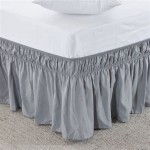Essential Aspects of Twin, Full, and Queen Bed Sizes
Selecting the ideal bed size is crucial for a comfortable and restful sleep experience. Twin, Full, and Queen beds are common choices, each offering unique dimensions and suitability for different needs. Understanding the key aspects of these bed sizes will help you make an informed decision.
Twin Bed Dimensions
Twin beds are the most compact of the three sizes, measuring 38 inches in width and 75 inches in length (97 x 191 cm). They are suitable for single sleepers, children, or guest rooms where space is limited. Twin beds are also often used in bunk beds or as trundle beds.
Full Bed Dimensions
Full beds, also known as "double" beds, provide more space than twin beds, measuring 54 inches in width and 75 inches in length (137 x 191 cm). They are a good option for single sleepers who prefer a wider sleeping surface or for couples who do not need a lot of space.
Queen Bed Dimensions
Queen beds are the most spacious of the three, measuring 60 inches in width and 80 inches in length (152 x 203 cm). They are ideal for couples who desire a comfortable and roomy sleep space. Queen beds also provide ample space for additional bedding, such as pillows and blankets.
Factors to Consider When Choosing a Bed Size
When selecting a bed size, consider the following factors:
- Number of Sleepers: Twin beds are suitable for single sleepers or children, while Full beds are ideal for single sleepers who want more space or couples with limited room. Queen beds are the best option for couples who prioritize comfort and space.
- Room Size: The size of your bedroom will determine the maximum bed size that you can accommodate comfortably. Measure your room before making a decision to ensure that the bed fits without overcrowding the space.
- Personal Preferences: Consider your individual sleep preferences. Do you prefer a cozy and compact sleep space or a more spacious and luxurious one? Your personal comfort level should guide your choice.
- Bed Frame: The dimensions of your bed frame should match the size of your mattress. Make sure that the frame you choose will accommodate the width and length of your desired bed size.
Additional Considerations
In addition to the essential aspects discussed above, here are a few additional considerations:
- Fitted Sheets: Ensure that you purchase fitted sheets that correspond to the specific size of your bed to ensure a snug and secure fit.
- Mattress Type: The type of mattress you choose, such as innerspring, memory foam, or hybrid, can influence the overall comfort and support of your bed.
- Comfort Preferences: Personal sleep preferences vary widely. Some individuals may prefer a firm mattress, while others prefer a softer one. Choose a mattress that aligns with your comfort level.
Conclusion
Choosing the right bed size is essential for a restful and rejuvenating sleep experience. By understanding the dimensions and key aspects of Twin, Full, and Queen beds, you can make an informed decision that suits your needs and ensures a comfortable sleeping environment. Consider the number of sleepers, room size, personal preferences, and other factors discussed in this article to find the ideal bed size for your sweet dreams.

Twin Vs Full Queen Which Mattress Size Is Right For You Amerisleep

Queen Bed Dimensions A Guide Nectar Sleep

Mattress Sizes Chart And Bed Dimensions Guide Amerisleep

Twin Vs Full Queen Which Mattress Size Is Right For You Nectar Sleep

Mattress Sizes And Dimensions Guide Clarity

Twin Vs Full Queen Which Mattress Size Is Right For You Dreamcloud

Mattress Size Chart Common Dimensions Of Us Mattresses Twin Bed Charts

Decoding Mattress Sizes And Dimensions Ncoa Org

The Ultimate Mattress Size Chart And Bed Dimensions Guide Sleep Advisor

Mattress Size Charts Dimensions Guide Advisor







